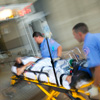Field Triage Decision Scheme: The National Trauma Triage Protocol
[Announcer] This podcast is presented by the Centers for Disease Control and Prevention. CDC - safer, healthier people.
Welcome to this CDC podcast on field triage. I'm Dr. Richard Hunt, Director of the Division of Injury Response in CDC's Injury Center.
To improve U.S. emergency care and standardize decision-making at an injury scene, the CDC, along with key stakeholders, published the development process and scientific basis for the revised field triage guidelines in the January 23, 2009 MMWR Recommendations and Reports, Guidelines for Field Triage of Injured Patients, Recommendations of the National Expert Panel on Field Triage.
Every day, approximately 800,000 EMS providers have a substantial impact on the health and safety of Americans. On average, EMS providers respond to nearly 16.6 million transport calls every year and work in approximately 15,000 EMS systems across the country. When an injury occurs, EMS providers have only minutes to decide what care is best for the injured persons. This decision process is known as "field triage" and can save lives. Research shows that if you are severely injured and transported to a Level One trauma center, your chances of survival increase by 25 percent.
To identify those at greatest risk for severe injury and determine the most appropriate facility to transport individuals with different types and severities of injury, EMS teams use an algorithm called a decision scheme. The Field Triage Decision Scheme is an essential component of the emergency care system. It helps guide EMS providers in transporting injured patients to the most appropriate facility, ensuring proper care and reducing the consequences of injury and death.
The current Field Triage Decision Scheme includes four steps.
Step One addresses physiologic criteria. This step guides EMS providers in identifying critically injured patients rapidly by measuring vital signs and assessing their level of consciousness. Identification of specific abnormalities or deterioration of vital signs necessitates transport to the highest level trauma center within the system.
Step Two addresses anatomic criteria and recognizes that certain patients, on initial presentation to on-scene EMS providers, might have a severe injury and need care at the highest level trauma center. These anatomic criteria are:
• A penetrating injury to the head, neck, torso, and extremities proximal to the elbow and knee,
• Flail chest,
• Two or more proximal long-bone fractures,
• A crushed, degloved, or mangled extremity,
• Amputation proximal to wrist and ankle,
• Pelvic fractures,
• Open or depressed skull fracture, or
• Paralysis
A patient who does not satisfy Step One or Step Two criteria might still have a severe, but occult, injury. Thus, Step Three addresses the mechanism-of-injury criteria, which includes falls from significant heights, as well as high-risk auto or motorcycle crashes. These patients should be transported to the closest appropriate trauma center, which, depending on the trauma system, need not be the highest level trauma center.
Step Four addresses special considerations. EMS providers must determine whether patients who have not satisfied physiologic, anatomic, or mechanism-of-injury criteria have underlying conditions or co-morbidities. These factors include extremes of age, anticoagulation and bleeding disorders, burns, a time-sensitive extremity injury, end-stage renal disease, or pregnancy greater than 20 weeks. For these patients, EMTs should contact medical direction and consider transport to a trauma center or a specific resource hospital. When in doubt, EMTs should take the patient to a trauma center.
Each day, EMS providers work to get every patient to the right place, at the right time, by making rapid on-scene triage decisions. In achieving this goal, they help ensure that more Americans live to their full potential.
For more information on the Field Triage Decision Scheme, including continuing education, or to request other free resources, please visit www.cdc.gov/FieldTriage.
[Announcer]For the most accurate health information, visit www.cdc.gov or call 1-800-CDC-INFO, 24/7.


